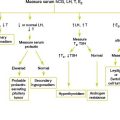Chapter 45 TRANSAMINASE ELEVATION
Causes of Transaminitis
Key Historical Features
Suggested Work-up
| ALT, AST |
Additional Work-up (May Be Indicated If Above Tests Are Normal)
| Chloride sweat test | If cystic fibrosis is suspected |
| Hepatitis A immunoglobulins | If hepatitis A infection is suspected on the basis of history and physical examination |
| Cytomegalovirus (CMV) immunoglobulins | If CMV infection is suspected |
| Epstein-Barr virus immunoglobulins | If Epstein-Barr virus is suspected |
| Acetaminophen and aspirin levels | If toxicity or overdose is suspected |
| Quantitative hepatitis C virus ribonucleic acid (RNA) | If hepatitis C antibody is positive |
| Liver ultrasonography | To evaluate for hepatic steatosis, cholelithiasis, cholecystitis evidence of cirrhosis, or a liver mass |
| Liver biopsy | May be indicated to exclude other diseases and to help make a specific diagnosis |
1. American Gastroenterological Association. Medical position statement: evaluation of liver chemistry tests. Gastroenterology. 2002;123:1364–1366.
2. Davison S. Celiac disease and liver dysfunction. Arch Dis Child. 2002;87:293–296.
3. Giboney P.T. Mildly elevated liver transaminase levels in the asymptomatic patient. Am Fam Physician. 2005;71:1105–1110.
4. Green R.M., Flamm S. AGA technical review on the evaluation of liver chemistry tests. Gastroenterology. 2002;123:1367–1384.
5. Kumar K.S., Malet P.F. Nonalcoholic steatohepatitis. Mayo Clin Proc. 2000;75:733–739.
6. Lavine J.E., Schwimmer J.B. Nonalcoholic fatty liver disease in the pediatric population. Clin Liver Dis. 2004;8:549–558.
7. Ludwig J., Viggiano T.R., McGill D.B., Ott B.J. Nonalcoholic steatohepatitis: Mayo Clinic experiences with a hitherto unnamed disease. Mayo Clin Proc. 1980;55:434–438.
8. Marion A.W., Baker A.J., Dhawan A. Fatty liver disease in children. Arch Dis Child. 2004;89:648–652.
9. Pineiro-Carrero V.M., Pineiro E.O. Liver. Pedaitrics. 2004;113:1097–1106.
10. Pratt D.S., Kaplan M.M. Evaluation of abnormal liver enzyme results in asymptomatic patients. N Engl J Med. 2000;342:1266–1271.
11. Swartz M.H. Textbook of Physical Diagnosis, 2nd ed. Philadelphia: WB Saunders; 1994. 302–336
































